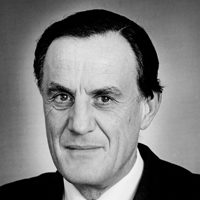Robert Hanbury Brown
Robert Hanbury Brown, AC FRS was a British astronomer and physicist born in Aruvankadu, India. He made notable contributions to the development of radar and later conducted pioneering work in the field of radio astronomy.
Robert Hanbury Brown,was a British astronomer and writer noted for his design, development, and use of the intensity interferometer.
Brown graduated from the University of London in 1935. During and after World War II he worked with Robert Alexander Watson-Watt and then E.G. Bowen to develop radar and its uses in aerial combat. In the 1950s he applied his experience with radar to radio astronomy, developing radio telescope technology at Jodrell Bank Observatory and mapping radio sources in the sky. This work led him to design a radio interferometer capable of resolving radio stars while eliminating atmospheric distortion from the image (1952). With Richard Q. Twiss, Brown applied the principles of radio interferometry to measuring the angular size of bright visible stars, thus developing the technique of intensity interferometry. Brown and Twiss set up an intensity interferometer at Narrabri in New South Wales, Australia, for the measuring of hot stars. From 1964 to 1981 Brown was a professor of physics and astronomy at the University of Sydney. He later served as president (1982–85) of the International Astronomical Union. His major books include The Exploration of Space by Radio (1957; with A.C.B. Lovell), The Intensity Interferometer (1974), and Man and the Stars (1978). His autobiography, Boffin, was published in 1991.

Robert Hanbury Brown
Date of Birth: 31 Aug 1916
Birth Place: Aruvankadu
Proffession: British astronomer
Nationality: United Kingdom
Death: 16 January 2002, Andover, United Kingdom


